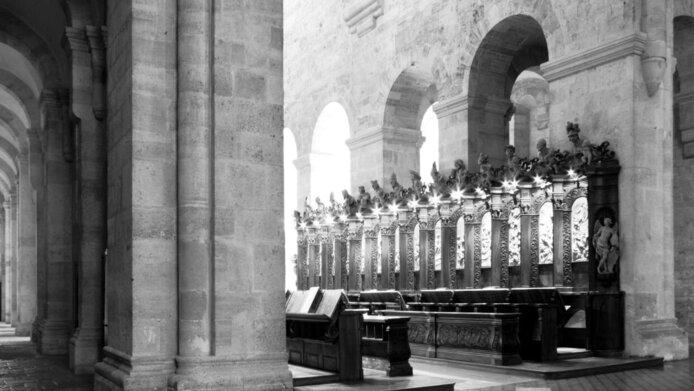Making furniture for church and nobility

You walk by, giving them no more than a side glance – under normal circumstances, pieces of baroque church furniture such as pews, confessionals or choir stalls do not attract great attention. And yet they display great craftsmanship, are significant in terms of art history and form part of our cultural heritage. With the support of the FWF, the art historian and former furniture restorer Michael Bohr embarked on a multi-year project in 2008, to draw up a catalogue of baroque furniture, including stylistic features, the period of manufacture or details about the local manufacturers. Although individual contributions on baroque furniture existed, a complete catalogue for the whole of Austria had not been available until now.
A detour via sacred furniture
Unlike the situation in other countries such as Germany or Italy, the Baroque furniture still owned by aristocratic families in Austria is strongly intermixed. When the aristocrats travelled, they took their interior furnishings along, which is why there can be no certainty about when and where a particular piece was made. To solve this problem, Bohr uses sacred furniture as a frame of reference. The originals found in religious buildings were mostly manufactured on site, or in the vicinity, and specifically for the respective church or monastery. “On the basis of sacred furniture from all regions of Austria, I am building a basic framework of secured data on stylistic features, manufacturing dates and producers,” explains Bohr. The complete catalogue Bohr is working on will comprise three volumes, containing an extensive collection of reference objects. The first volume has already been published and covers furniture from the eastern parts of the country; the second volume is due to be published in 2020. Both volumes cover more than 400 sets of furniture from 90 Catholic sacred buildings.
Several misconceptions uncovered
In his project, Bohr also deals with issues relating to sociology and economic history, which is in line with the international standards of furniture research. This concerns issues such as the awarding of commissions, but above all the working and living conditions of the manufacturers. “It has hitherto been assumed, for example, that carpenters made a satisfactory livelihood with the commissions they got from churches and monasteries. From probate inventories we have learned, however, that only a few of them ever achieved prosperity. Most of them lived in very humble circumstances,” says Bohr. He found most of the concomitant data in the Haus-, Hof- und Staatsarchiv maintained by the Austrian State Archives. Another assumption also needs to be revised: the pieces were not only crafted by master carpenters, but very often they were taken on by “journeymen”. At that time relatively few craftsmen were lucky enough to set up their own workshops, many remained “journeymen” for the rest of their lives. In terms of craftsmanship, they were often on a par with their masters. The biggest difference between the two related to mobility: master carpenters were sedentary with a permanent workshop, while journeymen went travelling. When a sacred building was newly built or rebuilt, word spread quickly among the well-connected craftsmen and many travelled in pursuit of the commissions. Heinrich Holdermann (1697-1739) was a case in point: “He was a carpentry journeyman from Westphalia. In 1721 he moved to Göttweig Abbey in Lower Austria, where the quality of his work was greatly appreciated. He was given a permanent position and later headed the abbey’s own carpentry workshop,” explains Bohr. However, there is little evidence that carpenters were handed on from one monastery to another by way of recommendation.
More freedom in monasteries
According to Bohr, the fact that monasteries could also use the services of journeymen was due to the fact that these craftsmen then enjoyed the protection of the monastery. “Guild rules, such as the one stipulating that only master carpenters are allowed to run a business and accept commissions, did not apply there.” Especially the monasteries in rural regions benefited from the high mobility of journeymen: Often there was either no master carpenter on site or the quality of their work was not convincing. As far as the territory of modern-day Austria is concerned one can say that more high-quality workshops were located north of the Alps, i.e. in Vienna, Lower Austria and Upper Austria, than in the west or south, because of the better trade opportunities. As Bohr’s research shows, the craftsmen themselves were often responsible for the artfully carved decorations and not only for the rough structure, to be then refined by a sculptor – there is now evidence for this. Because of their independence, monasteries were also able to use the skills of the countless journeymen carpenters who travelled through Europe.
Libraries connect two worlds
The libraries of monasteries are furnished with shelves and cabinets that do not fulfil any religious functions. Since this furniture was also produced on site, monastery libraries represent an ideal interface with secular Baroque furniture, as it is found in many collections. This is why Bohr is devoting his attention to them in a new research project, also supported by the FWF. This is the last building block to complete the catalogue. The knowledge that has been gathered about stylistic features, origin and manufacturing sites benefits mainly restorers and art dealers. It also increases the chance that the cultural value of Baroque furniture – whether highly ornate or rustic, whether in castles or sacred buildings – will attract more general attention. This is one of the basic prerequisites for preserving the existing pieces.
Personal details Michael Bohr lives in Vienna as a freelance art historian. A furniture restorer by training, he devoted himself to baroque furniture early in his career. Since 2008 he has been researching baroque items of furniture in Austrian sacred buildings. Bohr is also a lecturer on the history of furniture at the University of Vienna and until recently also lectured at the Vienna Academy of Fine Arts. The second volume of Sakralmöbel aus Österreich will be published in 2020.
Publications





